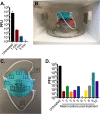Microwave-Generated Steam Decontamination of N95 Respirators Utilizing Universally Accessible Materials
- PMID: 32587063
- PMCID: PMC7317796
- DOI: 10.1128/mBio.00997-20
Microwave-Generated Steam Decontamination of N95 Respirators Utilizing Universally Accessible Materials
Abstract
The severe acute respiratory syndrome coronavirus 2 (SARS-CoV-2) pandemic has caused a severe, international shortage of N95 respirators, which are essential to protect health care providers from infection. Given the contemporary limitations of the supply chain, it is imperative to identify effective means of decontaminating, reusing, and thereby conserving N95 respirator stockpiles. To be effective, decontamination must result in sterilization of the N95 respirator without impairment of respirator filtration or user fit. Although numerous methods of N95 decontamination exist, none are universally accessible. In this work, we describe a microwave-generated steam decontamination protocol for N95 respirators for use in health care systems of all sizes, geographies, and means. Using widely available glass containers, mesh from commercial produce bags, a rubber band, and a 1,100-W commercially available microwave, we constructed an effective, standardized, and reproducible means of decontaminating N95 respirators. Employing this methodology against MS2 phage, a highly conservative surrogate for SARS-CoV-2 contamination, we report an average 6-log10 plaque-forming unit (PFU) (99.9999%) and a minimum 5-log10 PFU (99.999%) reduction after a single 3-min microwave treatment. Notably, quantified respirator fit and function were preserved, even after 20 sequential cycles of microwave steam decontamination. This method provides a valuable means of effective decontamination and reuse of N95 respirators by frontline providers facing urgent need.IMPORTANCE Due to the rapid spread of coronavirus disease 2019 (COVID-19), there is an increasing shortage of protective gear necessary to keep health care providers safe from infection. As of 9 April 2020, the CDC reported 9,282 cumulative cases of COVID-19 among U.S. health care workers (CDC COVID-19 Response Team, MMWR Morb Mortal Wkly Rep 69:477-481, 2020, https://doi.org/10.15585/mmwr.mm6915e6). N95 respirators are recommended by the CDC as the ideal method of protection from COVID-19. Although N95 respirators are traditionally single use, the shortages have necessitated the need for reuse. Effective methods of N95 decontamination that do not affect the fit or filtration ability of N95 respirators are essential. Numerous methods of N95 decontamination exist; however, none are universally accessible. In this study, we describe an effective, standardized, and reproducible means of decontaminating N95 respirators using widely available materials. The N95 decontamination method described in this work will provide a valuable resource for hospitals, health care centers, and outpatient practices that are experiencing increasing shortages of N95 respirators due to the COVID-19 pandemic.
Keywords: COVID-19; MS2 phage; N95; SARS-CoV-2; disinfection; respirator; reuse; sterilization.
Copyright © 2020 Zulauf et al.
Figures



Update of
-
Microwave-Generated Steam Decontamination of N95 Respirators Utilizing Universally Accessible Materials.medRxiv [Preprint]. 2020 Apr 25:2020.04.22.20076117. doi: 10.1101/2020.04.22.20076117. medRxiv. 2020. Update in: mBio. 2020 Jun 25;11(3):e00997-20. doi: 10.1128/mBio.00997-20. PMID: 32511577 Free PMC article. Updated. Preprint.
Similar articles
-
Microwave-Generated Steam Decontamination of N95 Respirators Utilizing Universally Accessible Materials.medRxiv [Preprint]. 2020 Apr 25:2020.04.22.20076117. doi: 10.1101/2020.04.22.20076117. medRxiv. 2020. Update in: mBio. 2020 Jun 25;11(3):e00997-20. doi: 10.1128/mBio.00997-20. PMID: 32511577 Free PMC article. Updated. Preprint.
-
Filtering Facepiece Respirator (N95 Respirator) Reprocessing: A Systematic Review.JAMA. 2021 Apr 6;325(13):1296-1317. doi: 10.1001/jama.2021.2531. JAMA. 2021. PMID: 33656543
-
Dry heat and microwave-generated steam protocols for the rapid decontamination of respiratory personal protective equipment in response to COVID-19-related shortages.J Hosp Infect. 2020 Sep;106(1):10-19. doi: 10.1016/j.jhin.2020.07.008. Epub 2020 Jul 9. J Hosp Infect. 2020. PMID: 32652212 Free PMC article.
-
Decontamination Methods for Reuse of Filtering Facepiece Respirators.JAMA Otolaryngol Head Neck Surg. 2020 Aug 1;146(8):734-740. doi: 10.1001/jamaoto.2020.1423. JAMA Otolaryngol Head Neck Surg. 2020. PMID: 32614377 Free PMC article. Review.
-
COVID-19 pandemic and personal protective equipment shortage: protective efficacy comparing masks and scientific methods for respirator reuse.Gastrointest Endosc. 2020 Sep;92(3):519-523. doi: 10.1016/j.gie.2020.04.048. Epub 2020 Apr 27. Gastrointest Endosc. 2020. PMID: 32353457 Free PMC article. Review.
Cited by
-
Heat and Humidity for Bioburden Reduction of N95 Filtering Facepiece Respirators.Appl Biosaf. 2021 Jun 1;26(2):80-89. doi: 10.1089/apb.20.0053. Epub 2021 Jun 2. Appl Biosaf. 2021. PMID: 36034691 Free PMC article. Review.
-
The COVID-19 pandemic and N95 masks: reusability and decontamination methods.Antimicrob Resist Infect Control. 2021 May 29;10(1):83. doi: 10.1186/s13756-021-00921-y. Antimicrob Resist Infect Control. 2021. PMID: 34051855 Free PMC article.
-
Transmission modes of severe acute respiratory syndrome coronavirus 2 and implications for infection control: a review.Singapore Med J. 2022 Feb;63(2):61-67. doi: 10.11622/smedj.2020114. Epub 2020 Jul 30. Singapore Med J. 2022. PMID: 32729311 Free PMC article. Review.
-
Evaluation of steam heat as a decontamination approach for SARS-CoV-2 when applied to common transit-related materials.J Appl Microbiol. 2023 Mar 1;134(3):lxad053. doi: 10.1093/jambio/lxad053. J Appl Microbiol. 2023. PMID: 36906281 Free PMC article.
-
Prophylaxis and Remediation for Future Pandemic Pathogens-(Lessons from a Post-COVID World).Microorganisms. 2022 Dec 5;10(12):2407. doi: 10.3390/microorganisms10122407. Microorganisms. 2022. PMID: 36557660 Free PMC article.
References
-
- Federal Register. 1995. Respiratory protective devices; final rules and notices. National Institute for Occupational Safety and Health, Centers for Disease Control and Prevention, US Department of Health and Health Services. Fed Regist 60:30335–30393.
-
- Bergman MS, Viscusi DJ, Palmiero AJ, Powell JB, Shaffer RE. 2011. Impact of three cycles of decontamination treatments on filtering facepiece respirator fit. J Int Soc Respir Prot 28:48–59.
Publication types
MeSH terms
Substances
Grants and funding
LinkOut - more resources
Full Text Sources
Other Literature Sources
Research Materials
Miscellaneous

